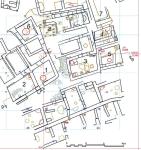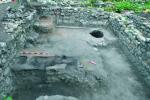Summary (English)
KASTRITSI FORTRESS (Igor Lazarenko – lazarenko@mail.bg, Maria Manolova-Voikova) Six houses around Church No. 2 were excavated, situated in the central part of the fortress. House No. 3 dated to the 14th – first decades of the 15th centuries. An earlier midden pit containing a coin of the Bulgarian King Ivan Alexander and a coin-like plate of the end of the 14th – beginning of the 15th century were discovered beneath the latest third floor level. Sherds and coins of the AD 340s and of the end of the 4th – beginning of the 5th centuries AD were found beneath the earliest first floor level of the house. The excavations of the Late Antique building situated beneath House No. 4 continued. Sherds and coins were discovered beneath its floor level, indicating that the building was abandoned after the AD 570s. House No. 5 measured 5.50 m by 4.80 m. Sherds and coins of the 14th century were discovered over the floor. A corner of a building of the 5th – 6th centuries AD was excavated beneath the Mediaeval house. House No. 6 measured 4.75 m by 4.20 m. Coins were discovered over its upper floor level, indicating that the house dated at the end of the 14th century. Two coins of the Bulgarian King Ivan Alexander were discovered over the earlier lower floor level of the house. House No. 7 measured 7.65 m by 3.70 m. It dated to the last decades of the 14th century and was built over a Late Antique wall. The Late Antique stratum contained sherds and coins from the last decades of the 5th century AD to AD 575. House No. 8 dated to the first half of the 14th century. Twenty-one graves were discovered in the cemetery around Church No. 2: 14 babies and children, one young individual, six adults and mature individuals. Two bodies were laid in wooden coffins. Flint splinters and black pebbles were discovered over the body of the child buried in Grave No. 2. The body of the old woman buried in Grave No. 2 was covered with charcoal. Six graves contained grave goods: buttons, a bead, earrings and a finger-ring. The cemetery appeared at the end of the 14th or the first decades of the 15th century. The finds from the excavations included iron tools, arrowheads, copper and glass jewelry, ceramic vessels, 90 coins mostly of the 6th century AD and of the 14th century, the earliest one being a coin of Odessos of the 3rd century BC, while the latest ones were Ottoman copper mangir of Emir Süleyman Çelebi dated to the first decade of the 15th century.
- Igor Lazarenko - Regional Museum of History – Varna
- Maria Manolova-Voikova - Regional Museum of History – Varna
Director
- Igor Lazarenko - Regional Museum of History – Varna
- Maria Manolova-Voikova - Regional Museum of History – Varna
Team
Research Body
- Regional Museum of History - Varna






![Download [PDF]](/excavation/skins/fasti/images/results/download_sml.png)

